Panasonic plasmas are widely considered by video enthusiasts to be the best flat-screen TVs available to buy on the market currently in terms of picture quality, but the Japanese brand’s LCD-based offerings have been playing second fiddle to models from Samsung and Sony for as long as we can remember. This poses a significant problem for the company: although its Viera plasma televisions command a loyal following among those who value image quality particularly in darkened home environments, the average consumer is more likely to splash out on an LED TV which is typically slimmer, brighter, greener and more versatile. Over recent years, plasma’s market share has slowly but surely been eaten up by LCD displays – a seemingly irreversible trend that is not lost on Panasonic.
It’s hardly surprising then to find the Osaka-headquartered TV manufacturer expanding its LED LCD lineup with each passing year. At its annual European convention held in France last month, Panasonic unveiled a record number of LED television models for 2013, spearheaded by the flagship WT65 series which comprises the 47-inch TX-L47WT65B and the 55-inch TX-L55WT65B.
The 42-inch Panasonic TX-L42E6B we’re reviewing today sits a good few rungs below the top-of-the-line WT65: in descending order, there exist the DT65, the FT60 and the ET60 before we reach the E6 series which is the highest-end non-3D LED LCD range. From another point of view, it’s also the lowest-end 2013 Panasonic LED HDTV equipped with the company’s new “My Home Screen” Smart TV interface.
Interestingly, besides being available as the 32″ TX-L32E6B, the Panasonic E6 series also comes in 39″ and 50″ flavours (known as TX-L39E6B and TX-L50E6B respectively), two screen sizes which have never graced the firm’s LED LCD line-up until now. As far as we’re aware, 39-inch LCD panels are made only by AUO (AU Optronics) and CMI (Chimei Innolux), indicating that Panasonic is getting its LCD panel supply from one or both of these Taiwanese manufacturers. Will this bring about an improvement in picture performance? There’s only one way to find out!
Updated 14 November 2013: Due to a drop in price to around £550 which makes it even better value for money, and after surveying competing models, we’ve upgraded the Panasonic TX-L42E6’s final rating from “Recommended” to “Highly Recommended”.
Design
Panasonic has certainly upped its game in the aesthetics department – even this midrange model features several classy stylistic cues that would do any flagship TV proud. First of all, the company has trimmed any excess fat from the matte silver bezel surrounding the LCD screen – it now measures less than a quarter of an inch in thickness along the top and sides. This widens slightly to half an inch along the bottom border, which is in turn adorned by a thin strip of transparent glass-like perspex bearing an elegant white Panasonic logo in the middle, as well as a small compartment on the left housing the power LED indicator, ambient light sensor and infrared signal receiver. The resultant floating/ “suspended in air” effect reminds us of similar design elements implemented on Sony’s high-end Bravia W, X and Z series a few years ago.
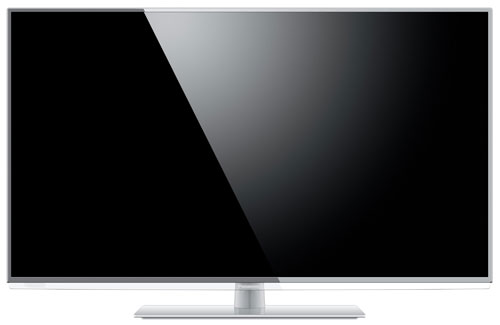
Being an edge LED LCD television, the TX-L42E6 is suitably slim in profile, though still slightly short of the size-zero slenderness seen on Samsung LED TVs. The upside is that the whole unit – ably supported on a non-swivelling pedestal stand whose rectangular base sports a finish that complements the bezel – feels sturdy and well-built.
Connections
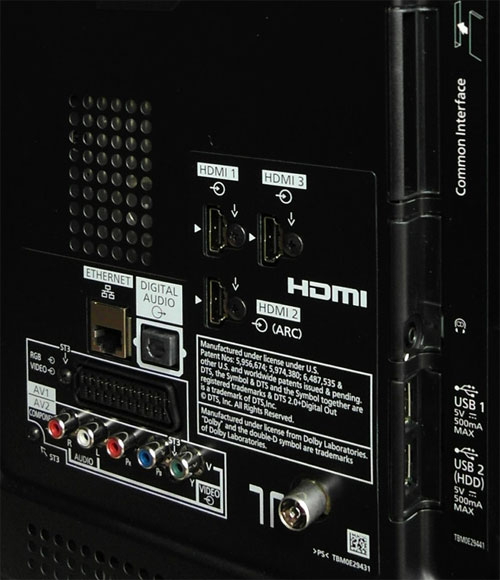 |
| 3 x HDMI, 2 x USB, CI slot, Component, SCART, Freeview HD tuner socket, LAN & audio outs |
Operation
Upon powering on the TX-L42E6B for the very first time, you’ll be guided through steps to set up “My Home Screen”, Panasonic’s new graphical user interface (GUI) that attempts to bridge the gap between traditional television and advanced “Smart” functionalities. By default, it consists of a larger window on the left side of the screen displaying the video feed, which is bordered by three Smart TV app widgets at the bottom, and an information panel on the right. For users who just want no-frills TV viewing, Panasonic has also sensibly offered a “Full Screen TV” option that does away with My Home Screen every time the television is switched on (although in this mode a Smart taskbar will still sit atop the screen for 3 seconds before disappearing).
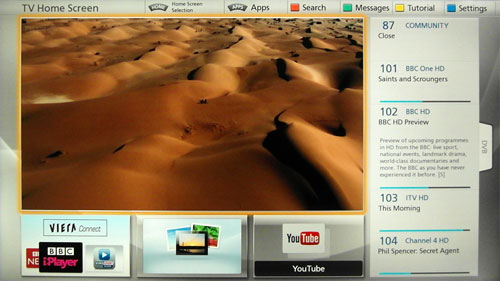
The actual picture menu itself presents a number of welcome enhancements. First is the long-overdue inclusion of a dedicated [Backlight] control that lets us adjust the overall luminance of the edge-mounted LED bulbs, which should prove extremely useful in maximising the dynamic range of the Panasonic Viera E6.
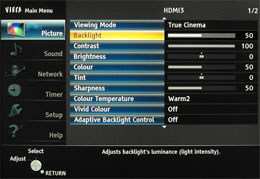 |
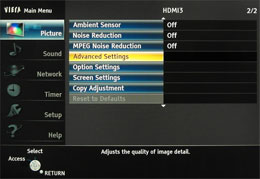 |
| [Picture] menu | |
Also new to UK models is the addition of numeric indicators to basic controls like [Contrast], [Brightness] and [Colour] – previously we’ve had to resort to descriptions like “2 clicks left from default” when publishing our calibrated settings! Furthermore, settings can now be saved independently per input across all picture viewing modes (another Panasonic first). This lends itself to the ability to map the adjusted values to the same or [Custom] picture preset on any other input via the [Copy Adjustment] function.
![[Advanced Settings] submenu](/news/wp-content/uploads/2018/04/hdtv_Panasonic-TXL42E6_advanced.jpg) |
![[Option Settings] submenu](/news/wp-content/uploads/2018/04/hdtv_Panasonic-TXL42E6_option.jpg) |
| [Advanced Settings] submenu | [Option Settings] submenu |
Five picture presets are available on the Panasonic TX-L42E6: “Dynamic“, “Normal“, “Cinema“, “True Cinema” and “Custom” which was not found on the manufacturer’s midrange Vieras last year. The last two will be the focus of our attention, since they house advanced calibration options such as 2- and 10-point [White Balance] controls, five [Gamma] presets ranging from “1.8” to “2.6” plus 10-point calibration, as well as 3-axis colour management system (CMS) for the red, green and blue primary colours.
Remote Control
The infrared remote supplied with the TXL42E6B is a standard Panasonic affair with well-sized rubberised keys, clear legible labelling, and decent tactile feedback. Ever so keen to promote its new “My Home Screen” interface, the company has placed a prominent [HOME] button at the top of the navigation ring. Another [APPS] button to its left provides access to the Smart TV applications page directly.
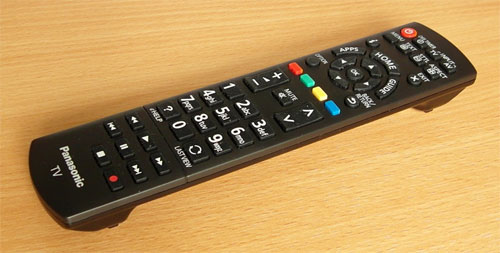
The matte front surface means that fingerprint and dust won’t show up easily. The clicker is not backlit.
EPG
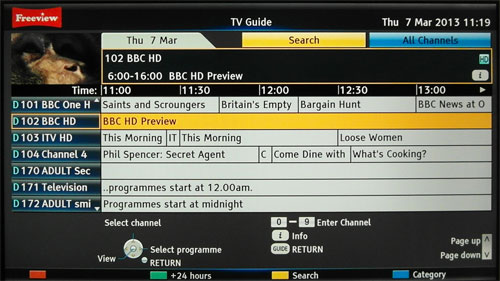
The electronic programme guide (EPG) on Panasonic Viera HDTVs over the past few years has been a pleasure to use owing to clean design, pin-sharp text, good use of complementary colours and responsive navigation. The one found on the E6 series is no different, with the added bonus that there’s now a small window at the top left showing the live preview video from the selected channel.
Viera Connect Smart TV Platform
Panasonic has totally revamped the layout of its Viera Connect internet-connected portal, with a 7×3 grid of rectangular app icons occupying the bottom half of the screen. Immediately above that is a row of seven, “protruding” icons that among other things grant access to the main menu, EPG and web browser. Navigational responsiveness and app launching were both quicker than last year’s iteration, but there remained some minor lagginess (think Android pre-Ice Cream Sandwich) which could be explained by the absence of “Hexa-Processing Engine” reserved for higher-end models.
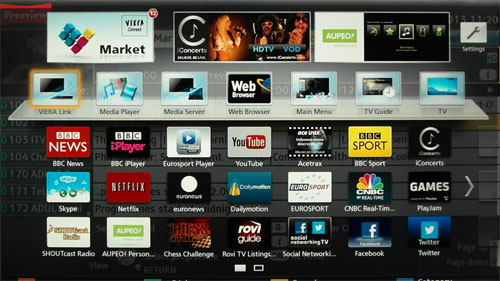
Content-wise, most of the popular Smart television apps (such as BBC iPlayer, YouTube, Twitter, Facebook, Skype and Netflix) are catered for, though LoveFilm is a notable omission. The Panasonic TX-L42E6B boasts integrated WiFi connectivity which certainly helps proceedings as far as convenience is concerned.
Calibration
Note: Our review sample was calibrated using CalMAN 5, the industry-leading video calibration software.
Greyscale
Out of the box, we changed the [Viewing Mode] on the Panasonic Viera TXL42E6B from its shipped default setting of “Normal” to “True Cinema“, as from past experience this should yield a greyscale closest to the D65 industry standard prior to any advanced calibration.
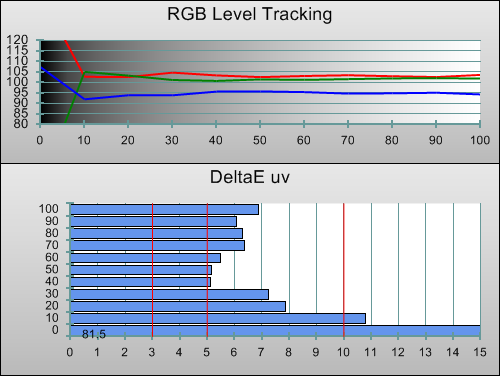 |
| Pre-calibration RGB tracking and delta errors (dEs) |
With all settings untouched in this picture preset, the on-screen image exhibited a red tint due to insufficient blue component. Thankfully Panasonic has included not only 2-point but also 10-point [White Balance] controls on the E6 LED TV, allowing us to tackle this issue head-on.
We first used the basic RGB cut and gain controls to bring greyscale into the ballpark of D6500, then – because we wanted to fulfill our insatiable hunger for perfection – went into the [More Detailed Adjustment] submenu (which contains the 10-point white balance controls) to individually finetune each 10% stimulus interval.
![Post-calibration RGB Tracking in [Movie] mode](/news/wp-content/uploads/2018/04/hdtv_Panasonic-TXL42E6_post-rgb.png) |
| Post-calibration RGB tracking and dEs in [True Cinema] mode |
The result was nothing short of stellar: delta errors (dEs) were reduced to less than 1 for the most part, ensuring that the majority of the image remains tint-free. We say “majority”, because once we put up a greyscale ramp pattern, we could still pick up very mild (and we do mean very mild) discolouration at 5% stimulus intervals (for example 15%, 25%, 35%, etc.) particularly at the lower end, indicating that Panasonic’s software isn’t interpolating the adjustments between each 10% stimulus interval. Nevertheless, this is an improvement over merely using 2-point white balance controls, and certainly ranks among the best results we’ve ever obtained on a flat-panel television.
Gamma
Pre-calibration gamma tracked closer to 2.2 than our 2.4 target which has been stipulated by the ITU as the EOTF (electro-optical transfer function) reference for flat-screen HDTVs used in dark-room studio mastering. Since 10-point [Gamma] controls are available on the TX-L42E6, we wasted no time in getting gamma to track as flat as possible to 2.4.
| Pre-calibration gamma tracking | Post-calibration gamma tracking |
The post-calibration chart on the right is as good a result as you’ll ever see on any display, period. A tip for calibrators: the 10-point white balance and gamma controls on our review unit were quite fine – we had to make relatively large chunks of adjustments (e.g. +5 or -5) before any visible/ measurable difference took place on screen.
Colour
On our TX-L42E6B review sample, the colour gamut in [True Cinema] mode was slightly compressed, in that red and green primaries were undersaturated compared to Rec. 709 HDTV specifications irrespective of whether [Vivid Colour] was enabled. By contrast, the [Custom] viewing mode presented a fuller gamut, but after spending some time with it (we were deciding between [Custom] and [True Cinema] for our final calibration), we discovered that once [Colour Temperature] was changed from the default setting of “Normal” to the more accurate “Warm2“, colours at sub-100% saturation intervals became severely oversaturated and inaccurate. In the end, we opted to calibrate in [True Cinema] mode, and arrived at the following results:
| Post-calibration CIE chart with saturation tracking |
Even though red and green (and as a consequence, all three secondary colours of cyan, magenta and yellow too) were undersaturated at 100% saturation points, the Panasonic TXL42E6 did very well at 25%, 50% and 75% intervals, ensuring that most midtone colours will appear on-hue and adequately saturated.
![Post-calibration Luminance levels in [True Cinema] mode](/news/wp-content/uploads/2018/04/hdtv_Panasonic-TXL42E6_post-colour-lum.png) |
| Post-calibration colour luminance (coloured bars = targets; black bars = measured values) |
Colour decoding was pretty much spot-on, which it should be since we generally give priority to colour luminance over hue and saturation in our calibration runs, mainly to prevent the dreaded red push from rearing its ugly head.
Benchmark Test Results
| Dead pixels | None |
| Screen uniformity | Mild backlight bleed and “dirty screen” effect |
| Overscanning on HDMI | 0% with [16:9 Overscan] set to “Off“ |
| Blacker than black | Passed |
| Calibrated black level (black screen) | Edge LEDs dim to 0.008 cd/m2 |
| Calibrated black level (ANSI checkerboard) | 0.0268 cd/m2 |
| Black level retention | Auto-dimming with full black screen |
| Primary chromaticity | Red and green slightly undersaturated |
| Scaling | Excellent |
| Video mode deinterlacing | Effective jaggies reduction |
| Film mode deinterlacing | Passed 3:2 over 480i & 1080i; and 2:2 over 576i |
| Viewing angle | Blacks and colours wash out beyond 30° |
| Motion resolution | 250-300 |
| Digital noise reduction | Defeatable |
| Sharpness | Defeatable edge enhancement |
| Luma/Chroma bandwidth (2D Blu-ray) | Full luma and full chroma with [1080p Pixel Direct] engaged |
| 1080p/24 capability | No judder |
| Input lag | 34ms compared to CRT TV |
| Full 4:4:4 reproduction (PC) | Yes, with [1080p Pixel Direct] engaged |
Power Consumption
| Default [Normal] mode | 44 watts |
| Calibrated [True Cinema] mode | 32 watts |
| Standby | <1 watt |


Nice review. May look at the fifty incher for our new lounge later on in the year. It’s only for the Mrs to watch telly on, so three dee isn’t really necessary. This in 50 inches is 900 quid. Sounds okay really.
@Daniel Osborne: Thanks for your kind words.
Wow the 50-incher is only £900? Going from 42″ to 50″ for only £100 extra is a good deal in anyone’s book!
I was really impressed by the blacks, partly because this sort of inkiness hasn’t been present on a Panasonic LCD-based TV before.
Warmest regards
Vincent
@Vincent Teoh:
Hi, How about TX-L50ET60E – does it still use LG FPR Panel ? ( as far as i know LG does not make 50 inch LCD panels ( at least till now )) .
Thanks.
Tps 899
@Kro: That’s an interesting question… I guess we’ll have to wait and see for ourselves.
@Daniel Osborne: Thanks for the heads up.
Warmest regards
Vincent
Thank you for a great review, Vincent.
I am very close to buying a 42″ these days. If you were in my place would you go for the (previous generation plasma) 42″ gt50 over the new gen led 42″ E series? (both at now £800)
@Bill: I would go for the Panasonic TX-P42GT50 plasma, unless you’re going to watch the TV a lot in brighter conditions (e.g. during daytime in a room with sunlight spilling onto the screen).
Warmest regards
Vincent
@Vincent:
This pretty much settles it then!
Thank you for your input and for taking the time to respond.
” indicating that Panasonic’s software isn’t interpolating the adjustments between each 10% stimulus interval.”
Okay, when its software doesn’t interpolate with RGB, how is it with the 10point gammaadjustment? Did you gain 2.4 and 2.2 up and down in the greyscale?
Hi vincent.
is the scrolling and resolution loss a particular issue watching ‘normal’ telly ? i ask because currently we have the sony hx853 which we have sold along with our yamaha vx673 to our house buyers. the jailbarring and dse under panning is particularly noticable, so blurring or jailbars ? hmmm, not sure i could live with both, even if the blacks were awesome.
regards,
daniel
@Marc Wessels: There’s no interpolation with the 10-point gamma controls too. What I did was, get overall gamma in the ballpark of 2.4 by setting [Gamma] to “2.4” (that was easy), and then used the [More Detailed Adjustment] to either increase or decrease the [Gain] at each 10% stimulus stops to get it to exactly 2.4. Hope my explanation is clear.
Warmest regards
Vincent
@Daniel Osborne: That’s the thing… once you’re aware of such issues, you’ll be looking for them. I wouldn’t say they were particularly noticeable on the unit I reviewed, but remember that they will probably be magnified at a larger screen size, such as the 50-inch you’re eyeing.
Warmest regards
Vincent
Thanks for the review Vincent.
I am trying to decide whether to buy the L37E5B (£429 in the sale) or save up for the L39E6B. Do you think the performance of the E6B is worth the extra investment bearing in mind that hdtvtest also awarded the E5B 8/10 last year!
Many thanks.
@Tom: Save up for the Panasonic TX-L39E6 – the superior black level (it uses a VA panel instead of the E5’s IPS panel) is worth every penny.
Warmest regards
Vincent
Thanks for this great review Vincent.
I’ve just purchased the TX-L39E6, and I’m in the process of setting the image quality, though I’m not an expert like you on this topic. Could you share your calibration settings including advanced details so I can fine tune my TV?
Hi! I’m interested in this TV, currently trying to figure out if I’d need anything more than 42″ (distance from TV is between 2 and 2.3 meters).
The only thing that worries me is the Motion resolution, as you point out it is one of the week spots. If I understand correctly that shouldn’t affect gaming as usually a ‘game mode’ just disables motion clarity all together right?
So what is the visual ‘glitches’ of having a poorer motion as seen on this tv? some kind of ‘tearing’ on fast scenes?
Cheers
Thanks for the review Vincent.
I’m now interested in this newer model having being ready to purchase TXL47EB,the only thing concerning me is the motion resolution.
I watch a lot of sport,mainly football,would the older model with the IPS panel still be the better bet?
Many thanks.
Hi – love your reviews! I was wondering if you could possibly post your recommended calibration settings for this TV?
Kind regards
Matt
Hi Vincent,
If you had to choose between 42E6 and 42ET60 which one would you get?
Thanks!
Hi – Nice review. Can you give more details about how this TV performs for gaming?? Where there any tests done on the input lag??
@Francisco: No tearing, just motion blur.
@Robert: For watching fast-action sports, a TV with motion-compensated frame interpolation (e.g. 100Hz) would be better.
@Dimitris: For me, it’s the E6 with the superior blacks. The ET60 does offer 3D and higher motion resolution though.
@Richard: Input lag was 34ms (under the Benchmark Test Results section, sorry I generally don’t write a separate paragraph on it), which is decent for gaming responsiveness, though behind the best-performing plasmas (for example the ST50).
@Carlos Navarrete & Matt: Calibrated settings will be posted on our Facebook page soon.
Warmest regards
Vincent
Hi Vincent,
Thanks for your response. Did you find a way to improve the responsiveness similar to other reviews like the LG where the aspect ratio was changed to 4:4:4 by renaming the HDMI as PC?
Thanks in advance,
@Richard
4:4:4 is related to color depth, on Panasonic it is called “1080p pixel direct mode” and it’s intended to accept full color information from computer and other 32bit sources
This tv was on display today next to an ET50 and a ES6800. The build quality is very bad, cheap plastic etc.
But the picture quality is amazing, nowhere near it’s price. I don’t know what they have done to produce such deep blacks. I switched to true cinema mode and turned off all dynamic processing etc and the colors were very natural with great contrast and detail. It’s a shame they don’t make one with MCFI and a better buld quality.
HI Vincent.
Thanks for your previous advice. I have another question!
I can see you have many to get through so apologies for adding another one!
My question is about the 39″ E6B and the AUO or CMI panel that you suggest it might use. Do these firms have a good track record for making quality panels? Do you think there might be a danger of a panel lottery with the 39″ as is the case with Samsung 37″ TV’s?
Many thanks.
@Tom
39″ is a new size and all panels are Super-MVA made by CHIMEI Innolux. Their contrast ratios and luminance values are very good, much better than a 2 year old 42″ or 47″. So if the viewing angles are ok I wouldn’t worry about it.
Look here for more info on panels:
http://www.panelook.com/sizmodlist.php?order=panel_id&by=desc&pagesize=30&production_state=1&sizes%5B%5D=39&lamp_type=WLED
@ Dimitris
Thanks for that info. I had a look at the Innolux panels on the link you gave me and have to be honest am not 100% sure what I should be looking for! There were various types of 39″ panels listed. They either had 3500:1 ratio or 5000:1 ratio. I trust Panasonic to choose the very best though so I am not overly concerned,
@Dimitris I worked out how to compare the panels listed under Innolux. D’oh! The higher ratio 39″ panels are 3D. These have *******-LS* and the ********-LE* are non 3D. These have 3500:1 ratio.
We are delighted that we settled on this model. It has a superb picture and the blacks in dark scenes are terrific. My wife was initially concerned that a 42inch screen would dominate the lounge but the set is so elegant and slim that it draws words of admiration even when switched off. Our grandsons love the smart interface too. Choose it and you won’t be disappointed!
Seen the 32″ version in shop today…quite different picture (better?) than the bigger E6s…circling around the TV, I could swear it was an IPS panel…
Vincent, can you try and confirm that with Panasonic? I believe people should expect the same performance from all screen sizes in a model…
@Kalos Geros
The 32″ version has an IPS panel according to the specs on panasonic website.
Good review and I have bought this TV. Regarding calibration. Can you not show what you did in the Panasonic menus in order to get the best results?
What I mean is show screen shots of the Panasonic menus and where the adjustments should be made and what they should be set to, to get the best results.
Hi Vincent,
Thank you for that great review. On its strength I’ve bought the TX-L39E6.
“Calibrated settings will be posted on our Facebook page soon.”
I’m in the throes of set-up and calibration. Can you publish your recommended setting?
With much appreciation,
Tony
How much degrees is the angle? Or at a certain distance, how much you can move by side?
Please please please please publish the recommended settings.
Thanks a lot!
Hi, thanks for your reviews! What do you think is better between this 42e6 and Samsung F6400?
I have checked the facebook page and can’t see the calibrated settings yet. Is this still on the cards?
Have the calibration setting for this TV been posted anywhere? I’m desperate for them!
Hello
Great review! i just bought this TV and it really looks great. I was wondering if you could possibly email me or post your recommended calibration settings for this TV?
Kind regards
George
Panasonic 42 E6b
Please let us have calibration settings for the E6B, switching from an old excellent Panasonic Quintrix CRT, we need them, we miss the old box, but this E6 ain’t bad at all, also good looking, we need to get nearer to the PQ of the Quintrix (13 years old and still good), but had to give it away, need space……..
Please, is there any way I could get calibration settings for this model? I would appreciate
Are there any recommended keyboards or mice that can be used with this TV
Does anyone at hdtvtest read these comments?
I’m adding my voice to the long list of people asking to see the calibration settings for this TV.
What good’s a review that gloats “we can do it, but we’re not sharing it”?
Come on hdtvtest; PLEASE publish the calibration settings for us lesser mortals.
CALIBRATION SETTINGS, CALIBRATION SETTINGS!…
I’m tired of tweaking, and blind guessing, come on you PRO’s!
;)
Well, you’re clearly not going to divulge recommended calibration settings, so let me make an observation about the TV.
There is a headphones output (thoughtful of Panasonic); it can double as an analogue feed to an audio system (yes, thoughtful). But Panasonic buried the headphone volume control several sub-menus deep in the software: , , , then to alter the volume. The conventional volume control has no influence on the level of the headphones.
Ooops, software trouble with greater-than/less-than signs:
“deep in the software: , , , then to alter the volume”
should be “deep in the software: push Menu, select Sound, select Headphones, then adjust left-right to alter the volume”
Hi,
Panasonic plasma’s give an image that is sometimes refered to an “analog” style image.
If not comparing contrast alone (yeah the plasmas are ahead) would a plasma still give a more analog image?
Or is a good LCD like this one also able to give an analog style image?
calibration settings
Viewing Mode: True Cinema
Backlight: 76
Contrast: 80
Brightness: -2
Colour: 50
Tint: 0
Sharpness: 0
Colour Temperature: Warm2
Vivid Colour: Off
Adaptive Backlight Control: Off
Ambient Sensor: Off
Noise REduction: Off
MPEG Noise Reduction: Off
Advanced Settings
Adaptive Gamma Control: Off
Black Expander: Off
Clear White Effect: Off
White Balance: R Gain 4, Green Gain 0, Blue Gain 3, Red Cuttoff 0, Green Cutoff 0, Blue Cutoff 0
Colour Management: R Hue 0, R Saturation 0, R Luminance -3, G Hue -14, G Saturation 0, G Luminance -5, B Hue -14, B Saturation 0, B Luminance -1
Gamma: 2.2
Option Settings
Film Cadence Mode: On
1080p Pixel Direct: On
Screen Settings
16/9 Overscan: Off
thanks Suresh – are these the settings used in the review?
I’ve seen these settings that Suresh has posted before on another site copied from the 50 inch version (link below) I doubt these are the same as fully calibrated professional results in this article. I tried them on my 42E6B and I found they didn’t quite look right especially the backlight being so high and the colour set low which was way different to my own results (not professionally calibrated) from the AVS HD709 and Spears & Munsil discs I own. Which came up with the following on True cinema, Backlight 50, contrast 90, brightness 0, Colour 58, (using THX blue glasses) Sharpness 40 (I like sharpness high as I use Sky HD and any lower the sky menus look funny to my eyes) Colour temperature Warm 1 (again to my untrained eyes and the spears & munsil disc despite everything I read online telling me Warm 2 is the closet to the 6500 standard) all other settings off and at their true cinema defaults. (I didn’t go into the advanced menus at all but I’m happy with the results so far but I stand to be corrected if I see other settings posted here)
Here’s the article I refereed to above.
http://www.avforums.com/threads/panasonic-tx-l50e6-reviewers-recommended-best-settings.1757970/
Was the calibrated settings ever posted anywhere from this review…?
Ex Pats forget this TV if you want Free View BBC ,ITV and other UK channels etc in Europe such as http://www.filmon.com as it will not download Flash Player for this website.
The EPG on the E6/E60/E61 does not have a reminder facility. These seems quite an omission compared to other TV brands. It is a TV after all.
hi vincent hoping you can clarify this for me, i have the 50′ version of the e6, you are saying the panel is 50hz, does that mean if im playing a game on my xbox one at 60fps the tv will be removing 10 frames? as in the tv takes 60fps and turns it into a 50hz signal?
kind regards Daniel.
This is a fantastic tv, the picture quality is excellent in both SD and HD, the motion blur, is only very slight, colours are excellent, the sound is very good too, for such a slim tv. Overall, a very well done tv by Panasonic.
i want to ask about BEST TV SELECTOR,why u give us a TV with a HIGH INPUT LAG while we already choose a HEAVY USE for Console Gaming and NO USE for the others,i mean if a TV is already have high input lag then to put it in the HEAVY USE Console Gaming CATEGORY ,this is silly, WATCH OUT FOR: High Input Lag (in Heavy Use for Console Gaming)
@eternallord: Sorry about your experience using the tool. Can you please let me know your selected screen size/ price and what was the result, so I can make some tweaks to the algorithm.
Warmest regards
Vincent
i simply choose the best 42-43″ Plasma TV for results,then,HEAVY USE for Console Gaming and NO USE TO LITTLE for the others,so u give 2 TVs as an options,fine,the first TV is Panasonic TXP42GT60 Plasma ( Watch Out For: 3D is quite dark; anti-reflection filter less effective than ZT) OK for this ,BUT Panasonic TXP42ST60 Plasma ( Watch Out For : HIGH INPUT LAG) what i mean,why u put such TV like this one for a HEAVY USE GAMING
I am still torn between the ET60 and the E6….god……
@nenito2k: E6 every day of the week. VA vs IPS, no contest.
Warmest regards
Vincent